Transforming Learning Spaces on a Budget: Action Research and Service-Learning for Co-Creating Sustainable Spaces
Abstract
1. Introduction
Research Questions
2. Method and Materials
2.1. Background of Action-Research before the Service-Learning Experience
2.2. Participant High Schools
2.3. Indicators Proposed for Description
3. Results and Discussion
3.1. Quantitative Results and Discussion
3.2. Qualitative Findings and Discussion
3.2.1. Lack of Space and a Need for Space Versatility
3.2.2. ICT and Active Methodologies
3.2.3. Sustainability
- Are renewable energies used for air-conditioning or heating systems? YES/NO
- Are renewable energies used for hot water in the gym? YES/NO
- Is there a system for greywater recycling and/or is there a system for rainwater harvesting for watering the school gardens? YES/NO
- Are there systems or devices for reducing electricity consumption? (motion sensors, programmable timers, LED luminaires) YES/NO
- Is recycling encouraged in the school curriculum with easy access to all types of containers: paper, plastic, glass, batteries, ICT waste? YES/NO
3.2.4. Brief Reflection about Budgets and Sustainability
4. A Service-Learning Experience for Improving Learning Spaces on a Budget
4.1. The Beginnings
4.2. The Way
- During September 2020, the research team contacted EASDA in order to share the proposal formulated by IES Severo Ochoa. A pair of virtual meetings were enough to contact leaders first and professors later, and so to promote a visit to the IES in order to find the peculiarities and needs of the high school in situ.
- In October 2020, EASDA students and teachers, together with two members of the university research team, visited the high school IES Severo Ochoa and participated in a design thinking workshop with fourteen 16-year-old students registered in the 4th year high school subject “Scientific Culture”. This group was prepared to initiate an educational project on sustainability. Two teachers at the high school and the principal also took part in the workshop. Due to the limitations of COVID-19, the number of vocational students during the visit was reduced to six participants, and active techniques used in design thinking workshops [39] that require moving around were restricted for sanitary reasons. However, the brainstorming for needs and solutions proved a success of participation, the EASDA students as “consultants” took notes and pictures of the spaces they were to work on, and the high school students felt they could express their needs and opinions in front of real future “designers”, teachers, and their own principal. “It was a feeling of being empowered” reported one of the teachers.
- In November 2020, back at the school of arts, information was transferred to the rest of the participants (vocational students and instructors). EASDA students, as “experts”, designed and prototyped ideas on the subject of “Interior Design and Project Management”. This work was incorporated by the professors at the school of arts into the curriculum of the first semester as part of the portfolio that would be used and evaluated as the final project of the semester. A total of 15 EASDA students participated, coming from two degrees, mostly individually, and nine of them (from the lowest school level) forming a unique team (seven projects were developed).
- In December 2020, seven models were presented to a board of evaluators formed by two members of the research team of the university, the principal of IES Severo Ochoa, and five professors of the EASDA. This time the interaction was all virtual and technology-based due to the sanitary lockdown. The model called “BIO-CLASS” (Figure 11) was chosen by the jury to be implemented, attending the main preferences of the principal of the high school, who was, without doubt, the person most in tune with the needs of the IES.
- In January 2021, the winning project was presented to the high school students, who evaluated it regarding the rubric prepared by teachers and researchers (basically how sustainability had been integrated into the project). The presentation also served as an excuse to assess their learning about the various types of materials and energy sources used in the design of the BIO-CLASS and studied during the course. The mean grade given by the students to evaluate the project was 4.2 on a scale of 1 to 5. The high school students will also participate in the gathering of recycled materials that will be used in their BIO-CLASS. During the spring and summer of 2021, the “BIO-CLASS” will be set up and will be ready to use as an extra learning space in September 2021 with an approximate cost of EUR 3000, using small local industries and the advice of a chartered engineer.
- In March 2021, vocational students concluded their Service-Learning experience, and before they started internships in businesses and companies to complete their vocational studies, the EASDA school organized an award ceremony. All students (15) received a gift and a certificate for participating in the Service-Learning project as “consultants”, plus the student whose project was chosen by the high school (“the client”) received from EASDA an economical bonus of EUR 100. Being a “real life” project, the experience can be used for their portfolio when seeking a job after graduation.
5. Conclusions
Author Contributions
Funding
Institutional Review Board Statement
Informed Consent Statement
Data Availability Statement
Conflicts of Interest
References
- García, A.; Muñoz, J.M. Pedagogía de los Espacios. Esbozo de un Horizonte Educativo Para el Siglo XXI. Rev. Española Pedagog. 2004, 228, 257–278. Available online: https://reunir.unir.net/handle/123456789/4120 (accessed on 1 June 2021).
- European Schoolnet Report. Guidelines on Exploring and Adapting Learning Spaces in Schools; European Schoolnet: Brussels, Belgium, 2017; pp. 1–56. Available online: https://fcl.eun.org/es/guidelines (accessed on 1 June 2021).
- Cheryan, S.; Ziegler, S.A.; Plaut, V.C.; Meltzoff, A.N. Designing Classrooms to Maximize Student Achievement. Policy Insights Behav. Brain Sci. 2014, 1, 4–12. [Google Scholar] [CrossRef]
- Guardino, C.A.; Fullerton, E. Changing Behaviors by Changing the Classroom Environment. Teach. Except. Child. 2016, 42, 8–13. [Google Scholar] [CrossRef]
- Ariani, M.G.; Mirdad, F. The Effect of School Design on Student Performance. Int. Educ. Stud. 2015, 9, 175. [Google Scholar] [CrossRef]
- Turunen, M.; Toyinbo, O.; Putus, T.; Nevalainen, A.; Shaughnessy, R.; Haverinen-Shaughnessy, U. Indoor environmental quality in school buildings, and the health and wellbeing of students. Int. J. Hyg. Environ. Health 2013, 217, 733–773. [Google Scholar] [CrossRef]
- Rantala, L.; Sala, E. Associations between classroom conditions and teacher’s voice production. Energy Procedia 2015, 8, 3120–3125. [Google Scholar] [CrossRef]
- Mihai, T.; Iordache, V. Determining the Indoor Environment Quality for an Educational Building. Energy Procedia 2016, 85, 566–574. [Google Scholar] [CrossRef]
- Allen, J. Building Evidence. In The 9 Foundations of a Healthy Building; Harvard, T.H., Ed.; Chan School of Public Health, Center for Health and Global Environment: Boston, MA, USA, 2017. [Google Scholar]
- Byers, T.; Imms, W.; Hartnell-Young, E. Evaluating teacher and student spatial transition from a traditional classroom to an innovative learning environment. Stud. Educ. Eval. 2018, 58, 156–166. [Google Scholar] [CrossRef]
- Woolner, P.; Thomas, U.; Tiplady, L. Structural change from physical foundations: The role of the environment in enacting school change. J. Educ. Chang. 2018, 19, 223–242. [Google Scholar] [CrossRef]
- Teba-Fernández, E.M.; Caballero-García, P.; Bueno-Villaverde, A. SHINE®: Modelo para la transformación de espacios educativos. Rev. Estilos Aprendiz. 2020, 13, 14–28. [Google Scholar]
- Nair, P. Blueprint for Tomorrow: Redesigning Schools for Student-Centered Learning; Harvard Education Press: Cambridge, MA, USA, 2014. [Google Scholar]
- Neuman, D. Building Type Basics for College and University Facilities; John Wiley & Sons: Hoboken, NJ, USA, 2013. [Google Scholar]
- Nabors, L.; Welker, K.; Faller, S. Impact of Service Learning: High School Students as Health Coaches for Children. J. Commun. Engagem. Scholarsh. 2018, 10, 10. [Google Scholar]
- Greenwood, D. Outcomes of an Academic Service-Learning Project on Four Urban Community Colleges. J. Educ. Train. Stud. 2015, 3, 61–71. [Google Scholar] [CrossRef][Green Version]
- Kaye, C. The Complete Guide to Service Learning: Proven, Practical Ways to Engage Students in Civic Responsibility; Academic Curriculum & Social Action; Free Spirit Publishing Inc.: Golden Valley, MN, USA, 2010. [Google Scholar]
- Kim, E.; Lee, Y.-J. Serve as you learn: Problem-based service-learning integrated into a product innovation and management class. Int. J. Costume Fash. 2018, 18, 29–43. [Google Scholar] [CrossRef]
- McNatt, D.B. Enhancing public speaking confidence, skills, and performance: An experiment of service-learning. Int. J. Manag. Educ. 2019, 17, 276–285. [Google Scholar] [CrossRef]
- Jackson, C.; Mohr-Schroeder, M.; Cavalcanti, M.; Albers, S.; Poe, K.; Delaney, A.; Chadd, E.; Williams, M.; Roberts, T. Prospective mathematics teacher preparation: Exploring the use of service learning as a field experience. Fields Math Educ. J. 2018, 3, 5. [Google Scholar] [CrossRef]
- Chiva-Bartoll, O.; Moliner, M.L.; Salvador-Garcia, C. Can service-learning promote social well-being in primary education students? A mixed method approach. Child. Youth Serv. Rev. 2020, 111, 104841. [Google Scholar] [CrossRef]
- Valverde-Esteve, T.; Salvador-Garcia, C.; Gil-Gómez, J.; Maravé-Vivas, M. Sustainable Service-Learning in Physical Education Teacher Education: Examining Postural Control to Promote ASD Children’s Well-Being. Int. J. Environ. Res. Public Health 2021, 18, 5216. [Google Scholar] [CrossRef]
- Vergés Bosch, N.; Freude, L.; Camps Calvet, C. Service Learning with a Gender Perspective: Reconnecting Service Learning with Feminist Research and Pedagogy in Sociology. Teach. Sociol. 2021, 49, 136–149. [Google Scholar] [CrossRef]
- Byker, E.J.; Ezelle-Thomas, V. Preparing Teacher Candidates with Global Competencies: Taking Action on the Global Water Crisis with Service Learning. J. Res. Child. Educ. 2021, 35, 268–280. [Google Scholar] [CrossRef]
- Red Española de Aprendizaje y Servicio. Available online: https://www.aprendizajeservicio.net/ (accessed on 1 June 2021).
- Sumarmi Bachri, S.; Baidowi, A.; Aliman, M. Problem-Based Service Learning’s Effect on Environmental Concern and Ability to Write Scientific Papers. Int. J. Instr. 2020, 13. [Google Scholar] [CrossRef]
- Aliyu, A.D.; Khata, M.J.; Buntat, Y.; Hatib, A.M. Potential of Service-Learning on Students’ Interpersonal Skills Development in Technical and Vocational Education. Asian Soc. Sci. 2014, 10, 1–9. [Google Scholar] [CrossRef]
- Lambini, C.K.; Goeschl, A.; Wäsch, M.; Wittau, M. Achieving the Sustainable Development Goals through Company Staff Vocational Training—The Case of the Federal Institute for Vocational Education and Training (BIBB) INEBB Project. Educ. Sci. 2021, 11, 179. [Google Scholar] [CrossRef]
- Smith, L.; Bratini, L.; Chambers, D.; Jensen, R.V.; Romero, L. Between Idealism and Reality: Meeting the Challenges of Participatory Action. Action Res. 2016, 8, 407–425. [Google Scholar] [CrossRef]
- Macdonald, C. Understanding Participatory Action Research: A Qualitative Research Methodology Option. Can. J. Action Res. 2012, 13, 34–50. [Google Scholar] [CrossRef]
- Colmenares, A. Investigación-acción participativa: Una metodología integradora del conocimiento y la acción. Voces Silencios 2012, 3, 102–115. [Google Scholar] [CrossRef]
- Walter, M. Chapter 21. Participatory Action Research. Social Research Methods. 2009. Available online: https://www.academia.edu/3563840/Participatory_Action_Research (accessed on 11 February 2021).
- Rocca, L.; Donadelli, G.; Ziliotto, S. Let’s Plan the School Garden: A Participatory Project on Sustainability in a Nursery School in Padua. Rev. Int. Geogr. Educ. Online 2012, 2, 220–243. [Google Scholar]
- Altrichter, H.; Kemmis, S.; McTaggart, R.; Zuber-Skerritt, O. The concept of action research. Learning Organ. 2002, 9, 125–131. [Google Scholar] [CrossRef]
- Kemmis, S. What is to be done? The place of action research. Educ. Action Res. 2010, 18, 417–427. [Google Scholar] [CrossRef]
- Turner, D. Qualitative interview design: A practical guide for novice investigators. Qual. Rep. 2010, 15, 754–760. [Google Scholar] [CrossRef]
- Montiel, I.; Mayoral, A.M.; Navarro Pedreño, J.; Maiques, S.; Marco Dos Santos, G. Linking Sustainable Development Goals with Thermal Comfort and Lighting Conditions in Educational Environments. Educ. Sci. 2020, 10, 65. [Google Scholar] [CrossRef]
- Ré, M.G.; Filippin, C.; Blasco Lucas, I. Niveles De Confort Térmico En Aulas De Dos Edificios Escolares Del Área Metropolitana De San Juan. Adv. Energías Renov. Medio Ambiente 2017, 5, 97–108. [Google Scholar]
- Saraiva, T.S.; de Almeida, M.; Bragança, L.; Barbosa, M.T. Environmental Comfort Indicators for School Buildings in Sustainability Assessment Tools. Sustainability 2018, 10, 1849. [Google Scholar] [CrossRef]
- Tahsildoost, M.; Zomorodian, Z.S. Indoor Environment Quality Assessment in Classrooms: An Integrated Approach. J. Build. Phys. 2018, 42, 336–362. [Google Scholar] [CrossRef]
- López Chao, V.A. El Impacto del Diseño del Espacio y Otras Variables Socio-Físicas en el Proceso de Enseñanza-Aprendizaje. Ph.D. Thesis, Universidad de Valladolid, Valladolid, Spain, 2016. Available online: https://dialnet.unirioja.es/servlet/tesis?codigo=61483 (accessed on 1 June 2021).
- Brown, T. Change by Design: How Design Thinking Transforms Organizations and Inspires Innovation; HarperBusiness: New York, NY, USA, 2009. [Google Scholar]
- Tschimmel, K. Design thinking as an effective toolkit for innovation. In Proceedings of the XXIII ISPIM Conference—Action for Innovation: Innovating from Experience, Barcelona, Spain, 17–20 June 2012; pp. 1–20. [Google Scholar] [CrossRef]
- Tonhauser, P. Design Thinking Workshop: The 12 Indispensable Elements for a Design Thinking Workshop; e-book; Academia: Berlin, Germany, 2015; Available online: https://www.academia.edu/24363369/Design_Thinking_Workshop_Pauline_Tonhauser (accessed on 1 June 2021).
- Mingaine, L. Leadership Challenges in the Implementation of Ict in Public Secondary Schools, Kenya. J. Educ. Learn. 2013, 2, 32–43. [Google Scholar] [CrossRef]
- Firmin, M.W.; Genesi, D.J. History and Implementation of Classroom Technology. Procedia Soc. Behav. Sci. 2013, 93, 1603–1617. [Google Scholar] [CrossRef]
- Mayoral, A.M.; Morales, J.; Aparicio, J.; Ortiz, L.; Quesada, M. TIC’s para la Docencia y el Aprendizaje. Editorial UMH. 2019. Available online: http://editorial.umh.es/2019/12/16/tics-para-la-docencia-y-el-aprendizaje/ (accessed on 9 August 2021).
- Benayas, J.; Marcén, C.; Alba, D.; Gutiérrez, J. Educación para la Sostenibilidad en España. Reflexiones Y Propuestas. OPEX. 2017. Available online: http://reds-sdsn.es/wp-content/uploads/2017/10/Informe-Educacion-Sostenibilidad-2017-web.pdf (accessed on 1 June 2021).
- Hernández-Barco, M.; Sánchez-Martín, J.; Blanco-Salas, J.; Ruiz-Téllez, T. Teaching Down to Earth—Service-Learning Methodology for Science Education and Sustainability at the University Level: A Practical Approach. Sustainability 2020, 12, 542. [Google Scholar] [CrossRef]
- UNESCO. Education for Sustainable Development: A Road Map; UNESCO: Paris, France, 2020; Available online: https://unesdoc.unesco.org/ark:/48223/pf0000374802 (accessed on 1 June 2021).
- Guía Didáctica. Conecta con los ODS. Genealitat Valenciana. 2021. Available online: https://cooperaciovalenciana.gva.es/documents/164015995/164149410/Gu%C3%ADa+did%C3%A1ctica+Conecta+con+los+ODS_+Versi%C3%B3n+imprimible/04e22925-cbb6-44f6-821f-b64703d55d74 (accessed on 21 June 2021).
- Bascopé, M.; Perasso, P.; Reiss, K. Systematic Review of Education for Sustainable Development at an Early Stage: Cornerstones and Pedagogical Approaches for Teacher Professional Development. Sustainability 2019, 11, 719. [Google Scholar] [CrossRef]
- Breiting, S.; Mayer, M.; Mogensen, F. Criterios de Calidad para Escuelas de EDS. Austrian Federal Ministry of Education, Science and Culture, Dept. V/11c 2005. Available online: https://www.ensi.org/global/downloads/Publications/211/QC-ESP.pdf (accessed on 1 June 2021).
- Crampton, F.E. Spending on school infrastructure: Does money matter? J. Educ. Adm. 2009, 47, 305–322. [Google Scholar] [CrossRef]
- Wargocki, P.; Wyon, D.P. Ten questions concerning thermal and indoor air quality effects on the performance of office work and schoolwork. Build. Environ. 2017, 112, 359–366. [Google Scholar] [CrossRef]
- COVID Protocol Generalitat Valenciana. Medidas de Actuación Frente a la COVID-19 Para el Curso Académico 2020–2021 en centros Educativos que Impartan Enseñanzas no Universitarias y sus Servicios Complementarios. Available online: https://ceice.gva.es/documents/161634256/172109626/Protocol_CAS.pdf/e6add099-06a5-4e0f-be89-d5b403aeabae (accessed on 20 July 2021).
- CSIC-IDAEA. Guide for the Ventilation of Classrooms; CSIC-IDAEA, Ministerio de Ciencia e Innovación y Mesura: Madrid, Spain, 2020; Available online: https://www.csic.es/sites/default/files/guia_para_ventilacion_en_aulas_csic-mesura.pdf (accessed on 11 February 2021).
- Determan, J.; Akers, M.A.; Albright, T.; Browning, B.; Martin-Dunlop, C.; Archibald, P. The Impact of Biophilic Learning Spaces on Student Success. 2019. Available online: https://cgdarch.com/wp-content/uploads/2019/12/The-Impact-of-Biophilic-Learning-Spaceson-Student-Success.pdf (accessed on 20 July 2021).
- Mozaffar, F.; Mirmoradi, S. Effective use of nature in educational spaces design. Organ. Technol. Manag. Constr. 2012, 4. [Google Scholar] [CrossRef]
- Berman, M.G.; Jonides, J.; Kaplan, S. The Cognitive Benefits of Interacting with Nature. Psychol. Sci. 2008, 19, 1207–1212. [Google Scholar] [CrossRef] [PubMed]
- Dorizas, P.V.; Assimakopoulos, M.N.; Santamouris, M. A holistic approach for the assessment of the indoor environmental quality, student productivity, and energy consumption in primary schools. Environ. Monit. Assess. 2015, 187, 1–18. [Google Scholar] [CrossRef]
- Toyinbo, O. Indoor Environmental Quality, Pupil’s Health and Academic Performance. Ph.D. Thesis, University of Eastern Finland, Kuopio, Finland, 20 December 2017. [Google Scholar] [CrossRef]
- Mumovic, D.; Palmer, J.; Davies, M.; Orme, M.; Ridley, I.; Oreszczyn, T.; Way, P. Winter indoor air quality, thermal comfort and acoustic performance of newly built secondary schools in England. Build. Environ. 2009, 44, 1466–1477. [Google Scholar] [CrossRef]
- Martínez, A.; Jordan, M.M. The relationship between indoor and outdoor levels of PM10 and its chemical composition at schools in a coastal region in Spain. Heliyon 2019. [Google Scholar] [CrossRef]
- Mora, F. Neuroeducación: Sólo Se Puede Aprender Aquello Que Se Ama; Alianza Editorial: Madrid, Spain, 2013. [Google Scholar]
- Hare, R.; Dillon, R. The Space. A Guide for Educators; EdTechTeam Press: Irvine, CA, USA, 2016. [Google Scholar]
- Montiel, I.; Mayoral, A.M.; Navarro Pedreño, J.; Maiques, S. Acoustic Comfort in Learning Spaces: Moving Towards Sustainable Development Goals. Sustainability 2019, 11, 3573. [Google Scholar] [CrossRef]
- Carulla, M.S.; Thornberg, J.M.; Rodríguez, S.M.; Borràs, J.B. De la educación del arquitecto a la arquitectura de la educación: Un diálogo imprescindible. Bordón 2016, 68, 165–180. [Google Scholar] [CrossRef]
- Updated Instructions School Infrastructure ELX- IES N11. Generalitat Valenciana. April 2019. Available online: http://www.ceice.gva.es/es/web/contratacion-educacion/proyectos-de-obras (accessed on 11 February 2021).
- Hughes, J.M.; Morrison, L.J. Innovative Learning Spaces in the Making. Front. Educ. 2020, 5, 1–17. [Google Scholar] [CrossRef]
- Plataforma de Contratación del Sector Público. Available online: https://contrataciondelestado.es/wps/portal/!ut/p/b0/DcqxCoAgEADQr2k-1wIHh9YgKMpb4lCJw9MkRPr8HB88QDgBMzW-qfKTSbqtD6EI5zj5UEkkXMKOK7ke4AAEZD83Aat2q9LzvSPVZvMW10UNCo3WUFIyP7b7dnY!/ (accessed on 1 June 2021).
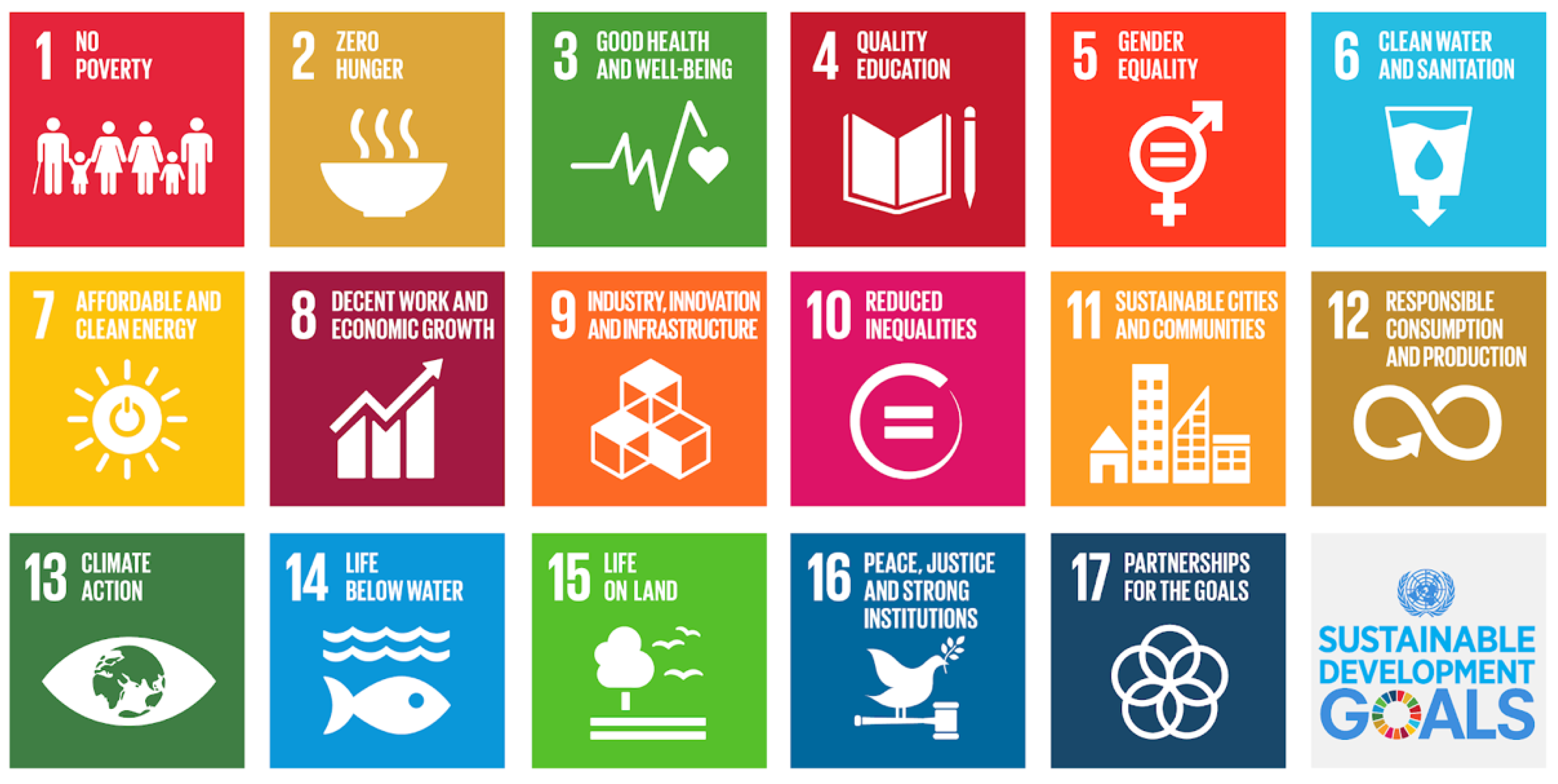
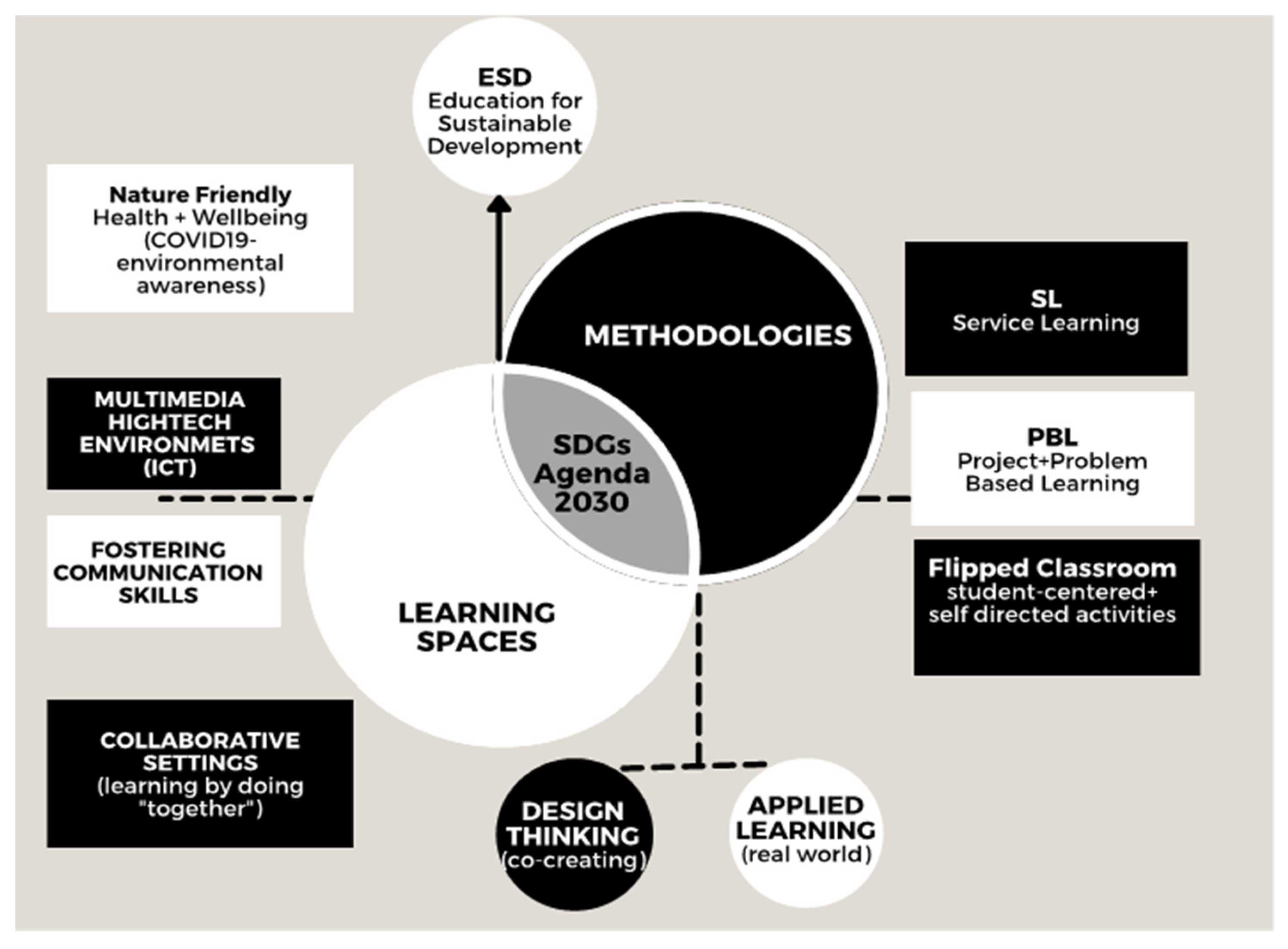
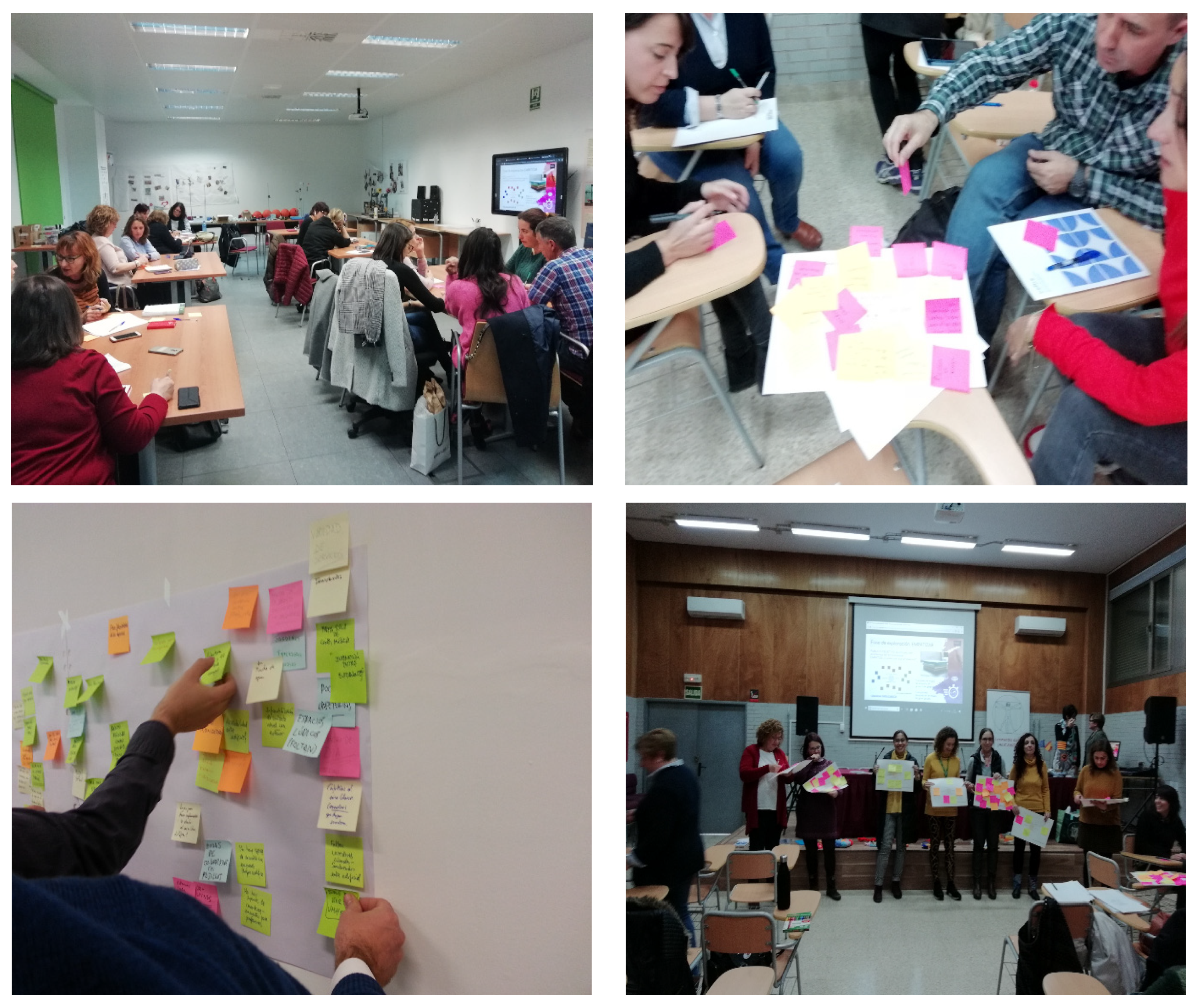
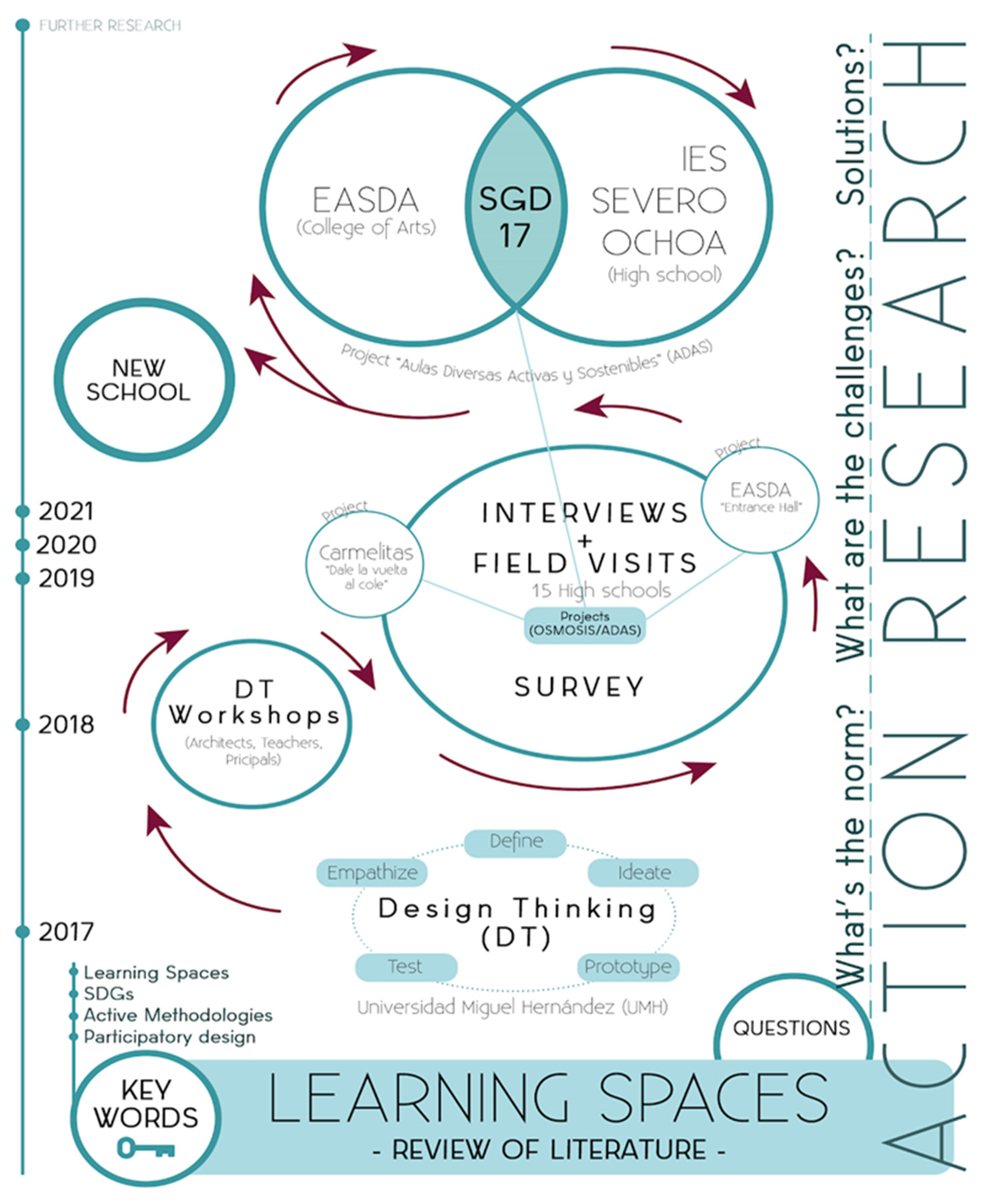

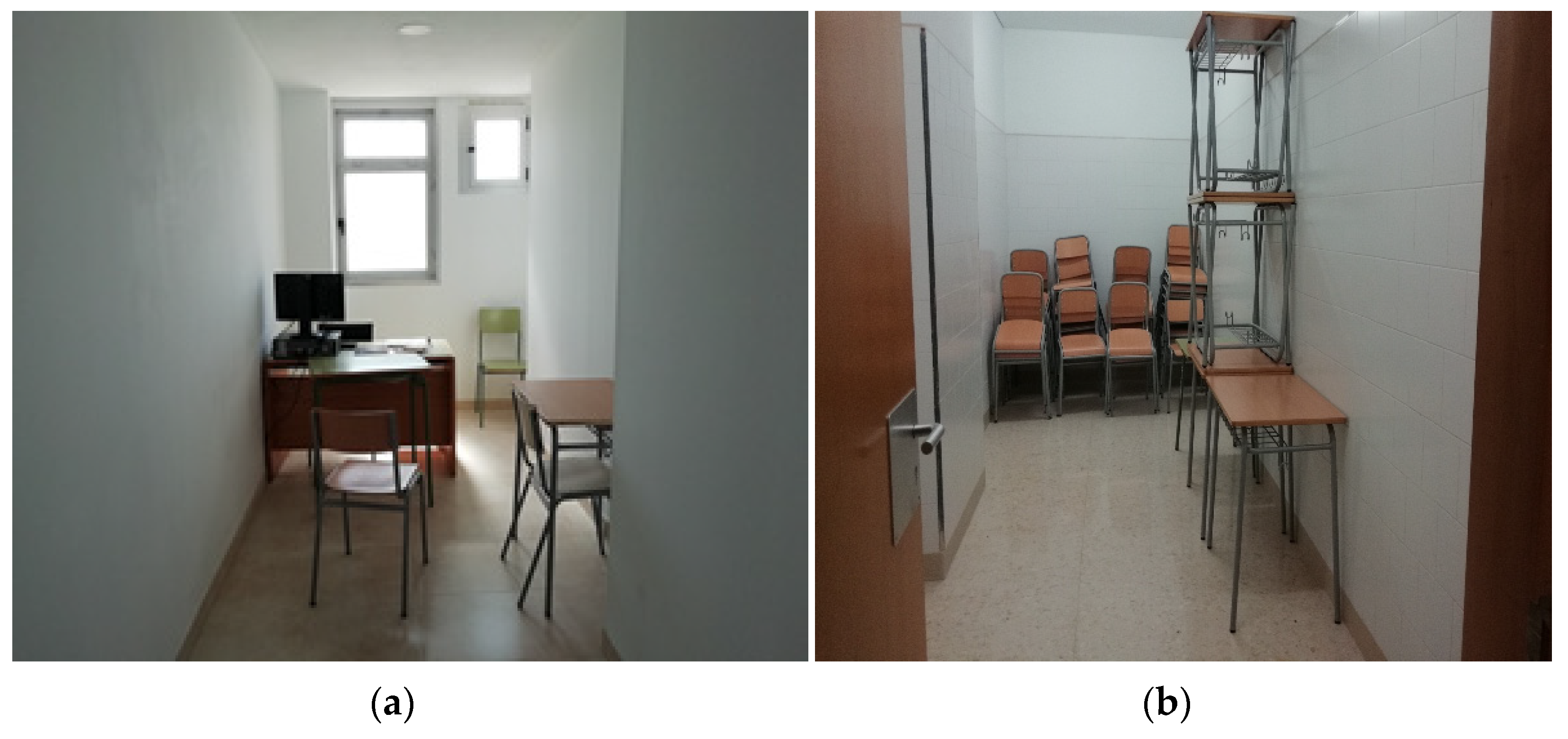
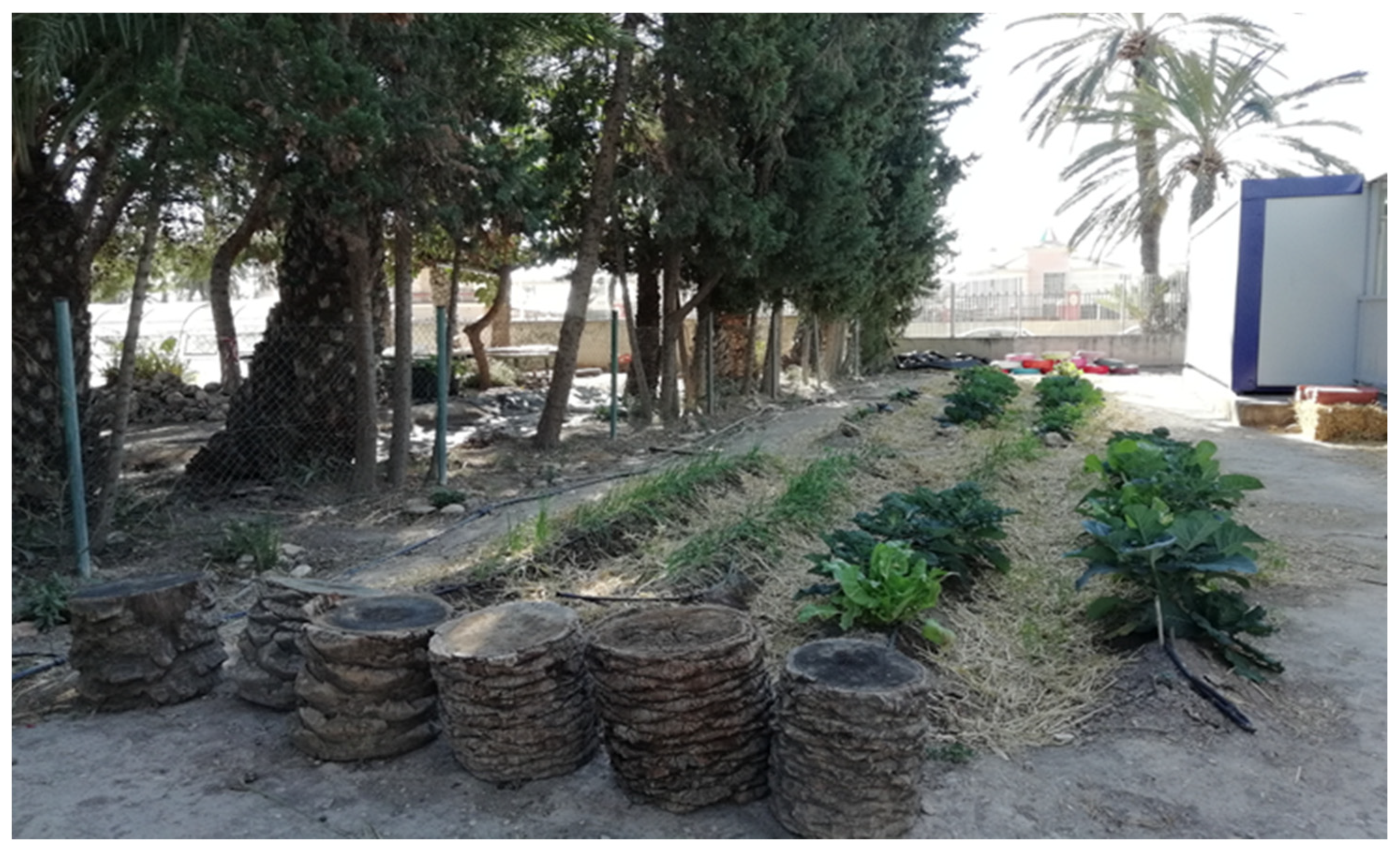
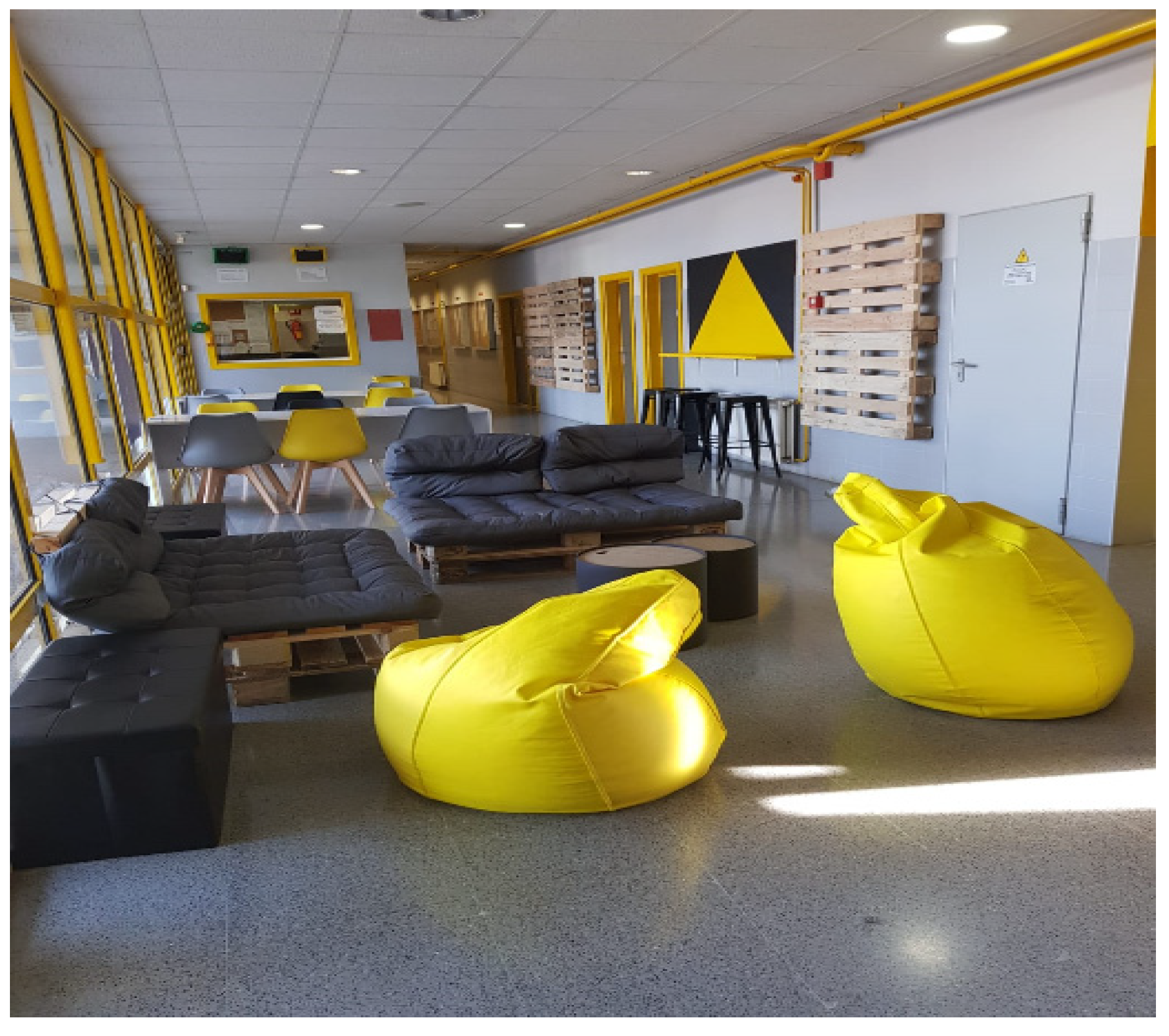
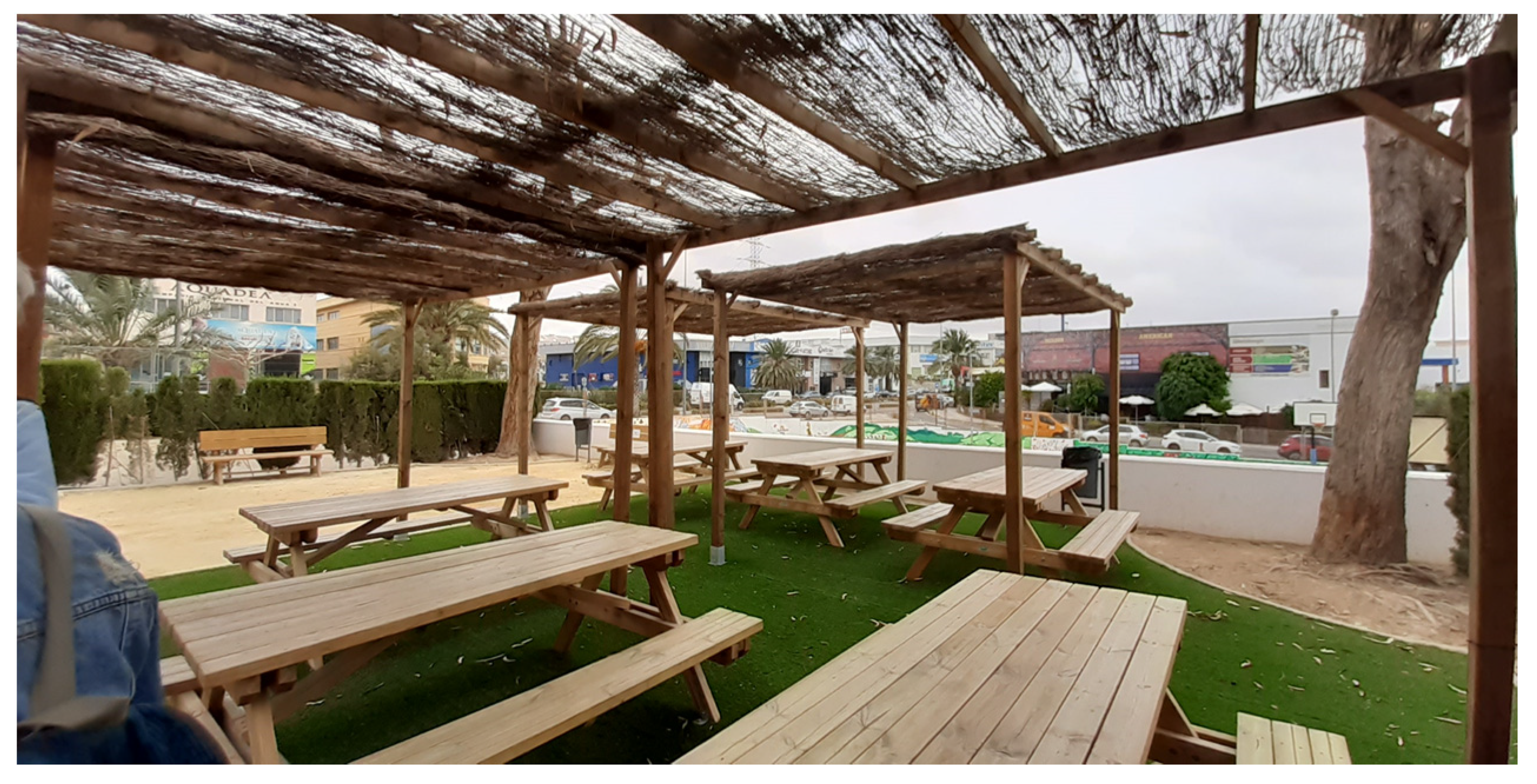
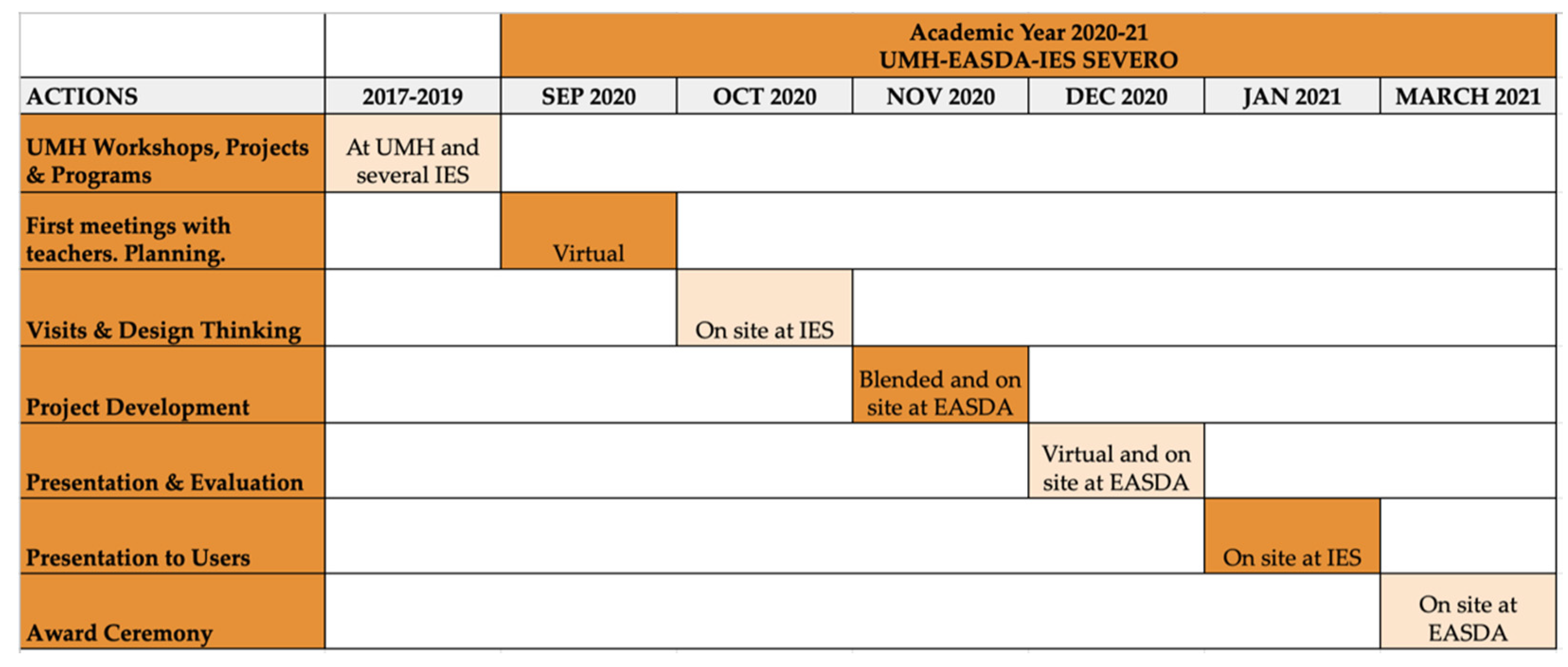
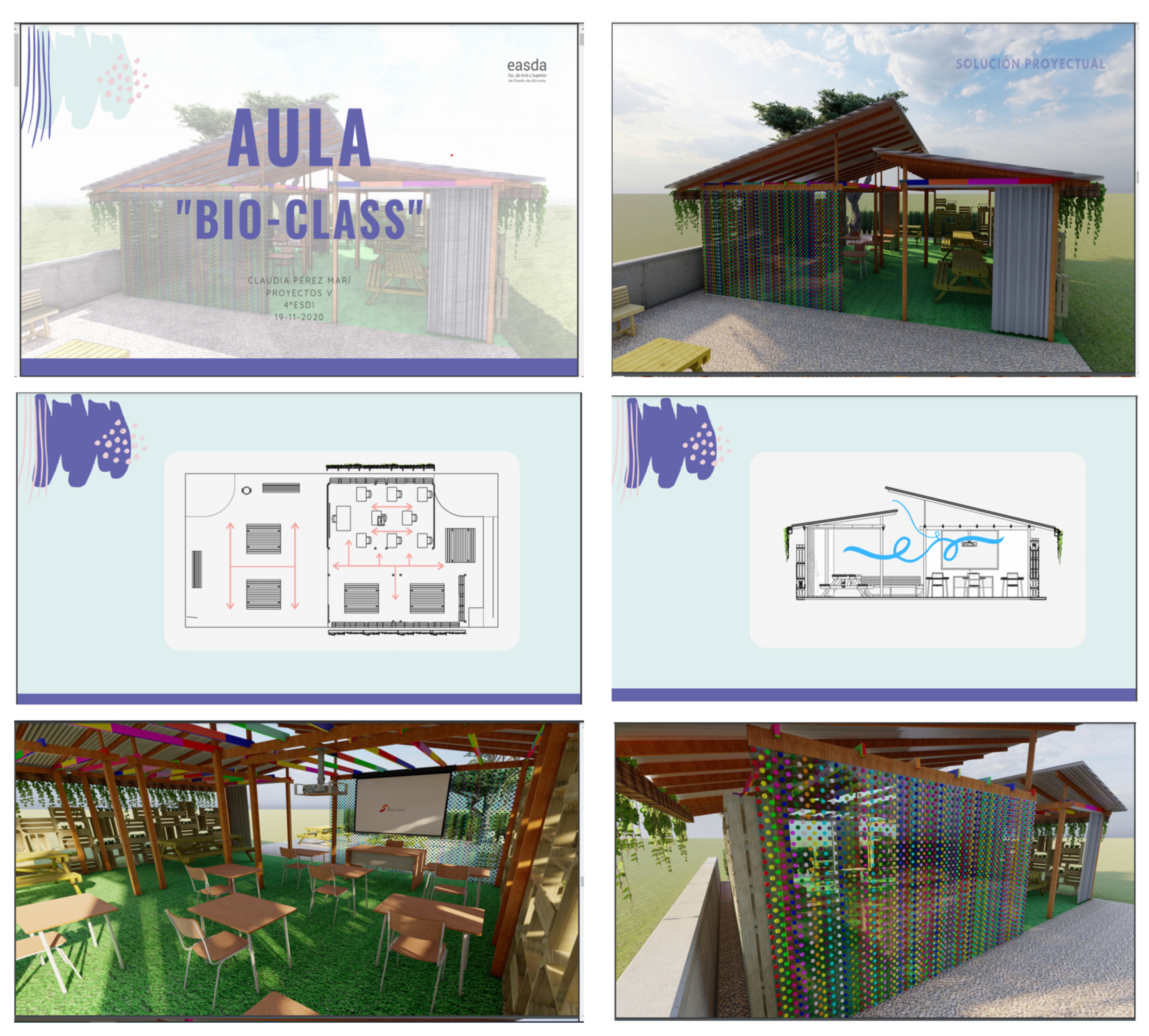
| IES | Construction Year/Refurbishment | Number of Teachers | Number of Students | Age Range | Opening Hours |
|---|---|---|---|---|---|
| La Asunción | 1963/1968 | 80 | 850 | 12–20 | 8–22 h |
| Carrús | 1975/1995 | 129 | 1200 | 12–50 | 8–22 h |
| Sixto Marco | 1955 | 131 | 1200 | 12–50 | 8–22 h |
| La Torreta | 1978 | 154 | 1400 | 12–50 | 8–22 h |
| Pedro Ibarra | 1979 | 62 | 460 | 12–20 | 8–15 h |
| Monserrat Roig | 1986/1987 | 100 | 1000 | 12–50 | 8–15 h |
| Tirant Lo Blanc | 1991 | 89 | 915 | 12–50 | 8–22 h |
| Severo Ochoa | 1994 | 88 | 900 | 12–50 | 8–22 h |
| Cayetano Sempere | 1994 | 103 | 1100 | 12–50 | 8–15 h |
| Victoria Kent | 1997 | 120 | 1300 | 12–50 | 8–22 h |
| Misteri | 2004 | 112 | 1200 | 12–20 | 8–15 h |
| Nit de L’Albà | 2004 | 92 | 917 | 12–30 | 8–15 h |
| Joanot Martorell | 2004 | 80 | 765 | 12–20 | 8–15 h |
| La Foia | 2004 | 65 | 500 | 12–20 | 8–15 h |
| Torrellano | 2004 | 80 | 800 | 12–20 | 8–15 h |
| Position | ACU | FRI | CLIM | CONNECT | EP | EFF | EXPO |
|---|---|---|---|---|---|---|---|
| INADEQUATE | 13.30% | 33.30% | 13.30% | 0.00% | 0.00% | 86.70% | 73.30% |
| ADEQUATE | 40.00% | 66.70% | 46.70% | 73.30% | 26.70% | 13.30% | 26.70% |
| OUTSTANDING | 46.70% | 0.00% | 40.00% | 26.70% | 73.30% | 0.00% | 0.00% |
| Construction | ACU | FRI | CLIM | CONNECT | EP | EFF | EXPO |
|---|---|---|---|---|---|---|---|
| Before 2000 | 6.67 (2.5) | 5.30 (1.09) | 7.73 (1.51) | 6.77 (1.19) | 8.71 (1.05) | 3.20 (1.23) | 3.33 (2.22) |
| After 2000 | 7.00 (0.75) | 6.32 (1.29) | 5.73 (1.38) | 6.94 (1.21) | 8.00 (0.78) | 3.00 (2.12) | 4.00 (2.79) |
| p-value t-test | 0.703 | 0.17 | 0.03 ** | 0.80 | 0.17 | 0.85 | 0.66 |
| SDG | Target | Outcomes |
|---|---|---|
| 3. Health and Wellbeing | 3.4 Promote mental health and wellbeing. | The BIO-CLASS guarantees protection against COVID-19. Provides natural ventilation and distance in a nature friendly learning space. |
| 4. Quality Education | 4.1 Quality secondary education leading to relevant and effective learning outcomes. 4.4 Increase the number of youth and adults who have relevant skills, including technical and vocational skills, for employment, decent jobs, and entrepreneurship. 4.7 Ensure that all learners acquire the knowledge and skills needed to promote sustainable development, including, among others, through education for sustainable development and sustainable lifestyles. 4.A Build and upgrade education facilities, inclusive and safe. | The teaching-learning approach used to co-create is an active methodology based on learning by doing with effective learning outcomes. |
| 7. Energy | 7.1 Access to affordable and modern energy services. 7.2 Increase renewable energy. 7.A Promote investment in energy infrastructure and clean energy technology. 7.B Expand infrastructure and upgrade technology. | The BIO-CLASS is an expanded outdoor room that uses natural light and ventilation. If possible, solar panels will be added for charging devices. |
| 8. Economic Growth | 8.6 Reduce the proportion of youth not in employment, education, or training. | The vocational students can include the project in their portfolio for future job interviews. |
| 9. Innovation and infrastructure | 9.1 Develop sustainable infrastructure. 9.5 Enhance scientific research. 9.C Significantly increase access to information and communications technology. | The space will be technology rich and with WIFI access. |
| 11. Sustainable cities and communities | 11.6 Reduce environmental impact of cities. 11.7 Provide universal access to safe, inclusive, and accessible, green and public spaces. 11.C Use of local materials. | Improvement of the recreation area with a green construction that promotes an attitude of caring for the environment. |
| 12. Responsible consumption and production | 12.5 Reduce waste generation through prevention, reduction, recycling, and reuse. 12.6 Encourage companies, especially large (school infrastructure dept.) to adopt sustainable practices. | Sustainable construction built mainly with recycled and reused materials and provided by students and local businesses. |
| 13. Climate action | 13.3 Improve education, awareness-raising, and human and institutional capacity on climate change. | Located in the SE of Spain, in a semi-desertic area, the BIO-CLASS is ideal for raising awareness on climate change. |
| 16. Peace and justice | 16.7 Ensure responsive, inclusive, participatory, and representative decision-making at all levels. | The participatory approach methods used for gathering ideas and taking decisions educate the students in responsibility and democracy. |
| 17. Partnerships | 17.16 Enhance the global partnership for sustainable development, complemented by multi-stakeholder partnerships that mobilize and share knowledge, expertise, technology, and financial resources. | In order to reach global partnerships we must learn to start with alliances with close, local entities. Both schools also participate in international Erasmus + programs. |
Publisher’s Note: MDPI stays neutral with regard to jurisdictional claims in published maps and institutional affiliations. |
© 2021 by the authors. Licensee MDPI, Basel, Switzerland. This article is an open access article distributed under the terms and conditions of the Creative Commons Attribution (CC BY) license (https://creativecommons.org/licenses/by/4.0/).
Share and Cite
Montiel, I.; Mayoral, A.M.; Navarro-Pedreño, J.; Maiques, S. Transforming Learning Spaces on a Budget: Action Research and Service-Learning for Co-Creating Sustainable Spaces. Educ. Sci. 2021, 11, 418. https://doi.org/10.3390/educsci11080418
Montiel I, Mayoral AM, Navarro-Pedreño J, Maiques S. Transforming Learning Spaces on a Budget: Action Research and Service-Learning for Co-Creating Sustainable Spaces. Education Sciences. 2021; 11(8):418. https://doi.org/10.3390/educsci11080418
Chicago/Turabian StyleMontiel, Isabel, Asunción M. Mayoral, Jose Navarro-Pedreño, and Silvia Maiques. 2021. "Transforming Learning Spaces on a Budget: Action Research and Service-Learning for Co-Creating Sustainable Spaces" Education Sciences 11, no. 8: 418. https://doi.org/10.3390/educsci11080418
APA StyleMontiel, I., Mayoral, A. M., Navarro-Pedreño, J., & Maiques, S. (2021). Transforming Learning Spaces on a Budget: Action Research and Service-Learning for Co-Creating Sustainable Spaces. Education Sciences, 11(8), 418. https://doi.org/10.3390/educsci11080418







